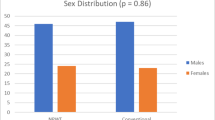Abstract
The use of pressure dressing to cover the sutured surgical wound is usually considered a routine conclusion to the repair of umbilical hernias in children. The wound is usually left dressed for a minimum of 5–7 days. The main purpose of pressure dressing is prevention of a hematoma formation. The aim of this study was to compare the surgical outcome after umbilical hernia repair in children when the wounds were covered using pressure dressing or left exposed without dressing after the completion of wound closure. Ninety-six patients with umbilical hernia repair were prospectively randomized to receive pressure dressing (n = 52) or have their wounds left exposed without any dressing (n = 44) after the completion of wound closure. None of the hernias were huge umbilical hernia and none required an umbilicoplasty. In the group who received pressure dressing, one patient developed wound infection 1.9% while no patients developed wound infection in the group who had their wounds exposed without any dressing. In children, there was no significant difference in terms of wound infection, hematoma or seroma formation and recurrence rate after applying pressure dressing or leaving the surgical wounds exposed without any dressing after completion of wound closure. Pressure dressing after umbilical hernia repair may be unnecessary.
Similar content being viewed by others
References
Garcia VF (2000) Umbilical and other abdominal wall hernias. In: Ashcraft KW, Murphy JP, Sharp RJ, Sigalet DL, Synder CL (eds) Pediatric surgery, 3rd edn. Saunders, Philadelphia, pp 651–653
Grosfeld JL (1995) Hernias in children. In: Spitz L, Coran A (eds) Rob and Smith’s operative surgery: pediatric surgery. Chapman & Hall, London, pp 222–238
Gross RE (1953) Surgery of infancy and childhood. W B Saunders, Philadelphia
Hahm SJ, Burd RS (2003) Cotton ball-vacuum compression for dressing small wounds. Pediatr Surg Int 19:748
Horan TC, Gaynes RP, Martone WJ, Jarvis WR, Emori TG (1992) CDC definitions of nosocomial surgical site infections, 1992: a modification of CDC definitions of surgical wound infections. Am J Infect Control 20:271–274
Katz DA (2001) Evaluation and management of Inguinal and umbilical hernias. Pediatr Ann 30:729–735
Merei J (2004) Pediatric clean surgical wounds: is dressing necessary?. J Pediatr Surg 39:1871–1873
Radhakrishnan J (1995) Umbilical hernia In: Nyhus LM, Condon RE (eds) Hernia, 4th edn. Lippincott Williams & Wilkins, Philadelphia, pp 361–371
Scherer LR III, Grosfeld JL (1993) Inguinal hernia and umbilical anomalies. Pediatr Clin North Am 40:1121–1131
Skinner MA, Grosfeld JL (1993) Inguinal and umbilical hernia repair in infants and children. Surg Clin North Am 73:439–449
Author information
Authors and Affiliations
Corresponding author
Rights and permissions
About this article
Cite this article
Merei, J.M. Umbilical hernia repair in children: is pressure dressing necessary. Ped Surgery Int 22, 446–448 (2006). https://doi.org/10.1007/s00383-006-1677-9
Accepted:
Published:
Issue Date:
DOI: https://doi.org/10.1007/s00383-006-1677-9




